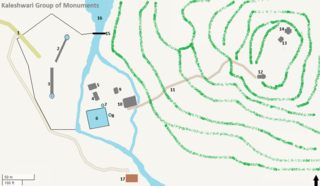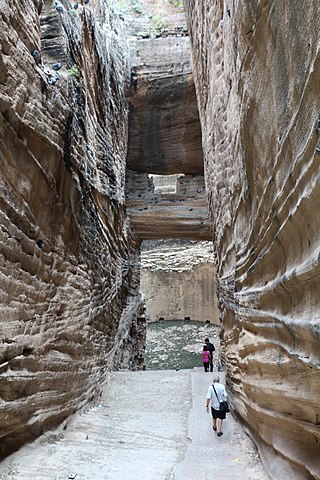
Mehsana, also spelled Mahesana, is a city and municipality in Mehsana district, in the Indian state of Gujarat. Established in 14th century, the city was under Gaekwads of Baroda State from 18th century to the independence of India in 1947. The municipality was established in 1919–20. The town has population of about 185,000. Dairy, oil and natural gas are major industries while there are several small and medium enterprises in the city.

Patan is the administrative seat of Patan District in the Indian state of Gujarat and is an administered municipality. It was the capital of Gujarat's Chavda and Chaulukya dynasties in medieval times, and is also known as Anhilpur-Patan to distinguish it from Prabhas Patan.

Bhavni Bhavai is a 1980 Gujarati film directed by Ketan Mehta, starring Naseeruddin Shah, Om Puri, Smita Patil, Mohan Gokhale, Benjamin Gilani. It tells the story of untouchability through folklore and Bhavai.

Palanpur is a city and a municipality of Banaskantha district in the Indian state of Gujarat. Palanpur is the administrative headquarters of Banaskantha district. Palanpur is the ancestral home to an industry of Indian diamond merchants.

Stepwells are wells or ponds with a long corridor of steps that descend to the water level. Stepwells played a significant role in defining subterranean architecture in western India from 7th to 19th century. Some stepwells are multi-storeyed and can be accessed by a Persian wheel which is pulled by a bull to bring water to the first or second floor. They are most common in western India and are also found in the other more arid regions of the Indian subcontinent, extending into Pakistan. The construction of stepwells is mainly utilitarian, though they may include embellishments of architectural significance, and be temple tanks.

The Sun Temple of Modhera is a Hindu temple dedicated to the solar deity Surya located at Modhera village of Mehsana district, Gujarat, India. It is situated on the bank of the river Pushpavati. It was built after 1026-27 CE during the reign of Bhima I of the Chaulukya dynasty. No worship is offered now and is protected monument maintained by Archaeological Survey of India. The temple complex has three components: Gūḍhamanḍapa, the shrine hall; Sabhamanḍapa, the assembly hall and Kunḍa, the reservoir. The halls have intricately carved exterior and pillars. The reservoir has steps to reach the bottom and numerous small shrines.

The Nagar Brahmin is a Hindu Brahmin subcaste mainly from the Indian state of Gujarat.

Khedbrahma is a town and a taluka headquarter in Khedbrahma Taluka of Sabarkantha district, Gujarat, India. It is situated on the banks of Harnav river. The town is connected with mythological history and has been pilgrim site for centuries. The 11th century Brahma, Ambika and Pankhnath Mahadev temples are the oldest monuments of the town. The town has an old stepwell, the Brahma Vav. It was under Parmaras, Chaulukyas and Pariharas before it came under Idar State in 13th century.
Vadnagar is a town and municipality in the Mehsana district of the state of Gujarat in India. It just about 35 km from Mehsana city. Its ancient names include Anartapura and Anandapura. It was a Buddhist location visited by Xuanzang in 640 C.E. Historian and archaeologist Alexander Cunningham has identified Anandapura with the town of Vadnagar.

Rani Ki Vav is a stepwell situated in the town of Patan in Gujarat, India. It is located on the banks of the Saraswati River. Its construction is attributed to Udayamati, the spouse of the 11th-century Chaulukya king Bhima I. Silted over, it was rediscovered in the 1940s and restored in the 1980s by the Archaeological Survey of India. It has been listed as one of the UNESCO World Heritage Sites in India since 2014.

Adalaj Stepwell or Rudabai Stepwell is a stepwell located in the small town of Adalaj, close to Gandhinagar city in the Indian state of Gujarat. It was built in 1498 in the memory of Rana Veer Singh by his wife, Queen Rudadevi.

Bai Harir Sultani Stepwell is a stepwell in Asarwa area 15 km off Ahmedabad, Gujarat, India.

Mata Bhavani's Stepwell or Mata Bhavani ni Vav is a stepwell in Asarwa area of Ahmedabad, Gujarat, India.
Stepwells are wells in which the water is reached by steps. They are most commonly found in western India especially Gujarat where over 120 such wells are reported. The origin of the stepwell may be traced to reservoirs of the cities of the Indus Valley civilization such as Dholavira and Mohenjo-daro. The stepwells were constructed in the south western region of Gujarat around 600 AD. From there they spread north to Rajasthan and subsequently to north and west India. Construction activities accelerated during the tenth to 13th century during the Chaulukya and Vaghela periods. The construction of these stepwells hit its peak during the 11th to 16th century. The Muslim rulers of the 13th to 16th century did not disrupt the culture that was practiced in these stepwells and encouraged the building of stepwells. The wells lost their significance in the 19th century due to introduction of water pumps and pipe-systems.

The Kaleshwari Group of Monuments, also known as Kaleshwari-Ni Nal, is located near Lavana village, Khanpur Taluka of Mahisagar district, Gujarat, India. It is near the district headquarters Lunavada and near a stream in Hidimba Van, the forest of Hidimba. The group includes intricately-carved temple ruins, two stepwells, a reservoir, structures with panels of erotic sculptures and idols scattered all over the site. The ruins are located at the foothills and on the hillock. They were built between the 10th and 16th century; some monuments were reconstructed after the 18th century. These are State Protected Monuments.
Mithi Vav is a stepwell located in Palanpur town of Banaskantha district, Gujarat, India. It is considered the only surviving monument of Parmara rule in the town. It was built around the 8th century. It is situated in the eastern part of the town. The five storey stepwell can be entered from the west. Based on its architectural style, it is believed that it is constructed in late medieval period but the sculptures embedded in the walls may belong to earlier period. The sculptures include that of Ganesha, Shiva, Apsaras, dancing figures, worshiping couples and floral or geometrical patterns. A worn out inscription found on one sculpture embedded in left wall cannot be read clearly, but the year Samvat 1320 can made out.

The Khed-Roda Group of Monuments include eighth-ninth century dated seven Hindu temples built during Gurjara-Pratihara or Rashtrakuta period. It also include a reservoir (Kund) and a stepwell. They are located between Raisingpura (Roda) and Khed Chandarani villages, 18 km from Himmatnagar in Sabarkantha district of Gujarat, India. It is located on the bank of the seasonal stream which merges Hathmati river downstream.

Boter Kothani Vav, also known as Mehsana Vav or Interi Vav, is a stepwell located in Mehsana, Gujarat, India.

Adi Kadi Vav or Adi Chadi Vav is a stepwell in Uparkot Fort, Junagadh, Gujarat, India. The date of its construction is uncertain.

Brahma Vav is a stepwell in Khedbrahma, Gujarat, India. It was built in 14th century.


















